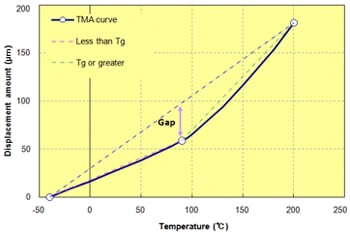- HOME
- Technical Information
- TORELINA™ PPS Resin
- Various Properties
- Thermal Properties
- Linear Expansion Coefficient
Linear Expansion Coefficient
 Fig. 6.6 TMA curve (A900)
Fig. 6.6 TMA curve (A900)
The linear expansion coefficient expresses the ratio of the initial dimension of a molded product to the amount of displacement due to thermal expansion per 1K increase in temperature. The linear expansion coefficient is calculated from a TMA curve (amount of displacement) determined using thermomechanical analysis (TMA), under non-oscillatory compression load (constant load), while changing the temperature of the test piece. (Fig. 6.6) In general, if the term "linear expansion coefficient" is used, this refers to the average linear expansion coefficient over a certain temperature range. As shown by the broken line on the TMA curve, it is assumed that a wide temperature range specified with two points exhibits a proportional (linear) relationship. Usually, the linear expansion coefficient of PPS resin increases when the glass transition temperature (near 90℃ to 95℃) is exceeded. For this reason, for a material for which the low- and high-temperature sides of the glass transition temperature differ greatly in their slope, such as in the case of unreinforced PPS, the gap may increase with the temperature if an average is calculated for a wide temperature range. In this case, the gap can be made smaller by dividing the temperature range at the glass transition temperature and determining the linear expansion coefficient within the two separate ranges.
The value of the linear expansion coefficient for reinforced PPS in the machine direction differs from that in the transverse direction, depending on the influence of the type of reinforcement, content, and flow orientation (anisotropy). The following shows the linear expansion coefficient of a test piece (10 × 5 × 3 mm t) cut out from the center of a flat plate (80 × 80 × 3 mm t) with a relatively low anisotropy. (Table. 6.2) The linear expansion coefficient depends on the reinforcement content. Cross-linked PPS tends to have a lower linear expansion coefficient than linear PPS. A feature of A575W20B is that changes in the linear expansion coefficient are small even at high temperatures equal to or greater than the glass transition temperature due to the effect of mineral filler.
Table. 6.2 Linear expansion coefficient of TORELINA™
| Item | Temperature range (℃) |
Units | Glass fiber reinforced |
Glass + filler reinforced | Elastomer improvement | Unreinforced | |||||
|---|---|---|---|---|---|---|---|---|---|---|---|
| A504X90 | A604 | A310MX04 | A610MX03 | A673M | A575W20 | A495MA2B | A900 | A670T05 | |||
| Machine direction (MD) |
-40 to 90 90 to 200 -40 to 200 |
×10-5/K | 2.1 2.8 2.4 |
2.0 2.8 2.4 |
1.5 2.1 1.8 |
1.6 2.2 1.9 |
2.1 2.2 2.2 |
1.8 2.0 1.9 |
1.9 2.2 2.1 |
4.6 10.9 7.7 |
5.1 11.0 8.0 |
| Transverse direction (TD) |
-40 to 90 90 to 200 -40 to 200 |
2.9 3.6 3.2 |
3.2 4.0 3.6 |
2.0 3.1 2.5 |
2.1 3.1 2.6 |
3.1 3.9 3.5 |
2.3 2.6 2.5 |
2.4 3.5 3.0 |
4.9 11.1 8.0 |
5.5 11.8 8.7 |
|